Nothing says Halloween like Bela Lugosi (at least for me)... and he is tightly associated with the character of Dracula, even if he only played the character on screen twice. As you get ready for Halloween, I recommend warming up by watching one movie from this set each Friday in October... and then relaxing on the night itself with one of the greatest "monster mash" movies of all time--also included among the seven movies in "Dracula: The Complete Legacy Collection". Each film included is a certified classic!
Even if I'm of the opinion that while the original Universal Studio's "Dracula" film, one of the very important first building blocks of the cinematic horror genre, it is also is overrated.
Watching it in close proximity to the sequels from the 1930s and 1940s and, more importantly, to the Spanish-language "Dracula" that was filmed simultaneously to the English-language version and on the same sets but with a different cast and crew, I am more convinced than ever.
Without "Dracula," the horror film industry as we know it would never have come to be. However, the movie is inferior to "The Mummy" and "Frankenstein" and even the independently produced, Bela Lugosi-starring, low budget chiller "White Zombie" are far better movies. It's not even as good as the Spanish-language "Dracula." In fact, the only thing better in the English version of Dracula than the Spanish version is Bela Lugosi. The guy doing Dracula in the Spanish version isn't even in the same league.
Both of Universal's 1931 versions of "Dracula" and immediate sequels are available in a very affordable, very well put together package. (My only complaint is that they included "House of Dracula" in this set instead of putting it the Wolf Man Legacy Collection... but more on that when I post my reviews of the movies included in that set.)
Dracula (1931)
Starring: Bela Lugosi, Dwight Frye, Helen Chandler, Edward Van Sloan, Herbert Bunston, David Manners, and Charles K. Gerrard
Director: Tod Browning
Rating: Seven of Ten Stars
Count Dracula (Lugosi) travels to England where he sates his bloodlust on young women, including the lovely Mina (Chandler).
Universal's 1931 "Dracula" was the first horror talkie and is one of the three most influential horror films ever made. It's a film that's truly a significant milestone not only in film history, but in pop culture as well, and, even though its age is showing, it's a genuiine classic.

I don't think anything quite as subtly creepy and startling as Dracula passing through a mass of cobwebs without breaking them has ever been put on film. It's a perfect film moment, because the feeling of "waitaminnit... did that just happen?" that Renfield (Frye) has is shared by the audience, and we're sitting there with a chill that goes right down to our very bones.
Because this film is such a classic milestone, I feel a bit awkward about not liking it more than I do. Like "Frankenstein" (also made by Universal in 1931), this movie has nearly as many flaws as it has elements of perfection.
The biggest problem with "Dracula" is the haphazard way the film unfolds, particularly in its second half. The vampiric Lucy and her preying on little children is dealt with a throw-away fashion, and the climactic encounter at Carfax Abby, which is so weakly and disjointedly handled that it is barely a climax at all. (It's particularly disappointing that Dracula's death happens entirely off-screen, except for a very effective reaction from the psychically bonded Mina.)
In fact, in many ways, it's almost as if someone forgot the movie needed a script, and it was made up as the crew went along. The film is worth seeing for spectacular performances from Bela Lugosi (it's easy to see why he solidified vampires as suave, sharp-dresserrs as opposed to fugly scarecrows like the one featured in "Nosferatu"), Dwight Frye (who, as Renfield, is as much a star of the film as Lugosi, and who does some great acting when he vascilates from raving madman to apparently sane and back again), and Helen Chandler (who, as Mina, conveys more with her eyes, body language, and facial expressions than one would thinks possible, and who has the only decent moment during the film's climax as she shares in Dracula's pain as Van Helsin stakes him). The film's impressive sets and creative camera work also bring about some genuinely creepy moments, such as when Dracula and his vampire brides emerge from their coffins under his Transylvanian castle, and then when they later close on an unconscious Renfield; the discovery of Renfield in the hold of the death ship after it runs aground; Dracula's feeding upon the flower girl in London; Renfield crawling across the floor toward an unconcious maid with a look of madness and bloodlust on his face; Mina's transformation as she urges John Harker to get rid of Van Helsing and his crucifixes; and Dracula and Mina's arrival at Carfax Abby.
But, for every great moment or spectacular performance, there's a boring one, or one where opportunities that should have been obvious to filmmakes even in 1931 are completely missed. Edward Van Sloan (as Van Helsing) and David Manners (as a particularly milquetoasty Harker) are completely dead spots in the film, giving weak performances that almost manage to drag down those excellent ones from Chandler, Frye, and Lugosi. (In fact, Van Sloan and Manners are so weak here that it's surprising to me that they;'re the same actors who do so well in "The Mummy" just one years later. (Perhaps the better script and a different director made all the difference for them.)
By the way, the new score that Phillip Glass composed for the restored version of the film included in the "Dracula Legacy Collection" (and which can be toggled on and off) is actually a fine reflection of the movie itself: Glass has some good moments and some supremely weak moments in his score. For the most part, it is just Muzak that doesn't seem to have a whole lot to do with enhancing the mood on the screen, but every so often, it is spot-on and it makes the film that much more impressive. (Glass's music ALMOST gives the film's climax some impact, for example.)
Although far from perfect, the 1931 "Dracula" is a must-see for anyone with an interest in examining the origins of horror as a separate and unique genre. While I'll take "White Zombie" or "The Mummy" over this film any day, I think the 75 minutes it takes to watch this film, is time well spent.
Dracula (1931 Spanish version)
Starring: Carlos Villar, Pablo Alvarez Rubio, Lupita Tovar, Barry Norton, Eduardo Arozamana and Carmen Guerrero
Director: George Melford
Rating: Seven of Ten Stars
Count Dracula (Villar) travels to London--where everyone suddenly has taken to speaking Spanish and being Catholic--and sets his undead sights on the sexy Lucia (Guerrero) and the beautfiul, virginal Eva (Tovar). Will occult expert Dr. Van Helsing (Arozamana) and Eva's fiance Juan (Norton) save her from the fiend's embrace of death?
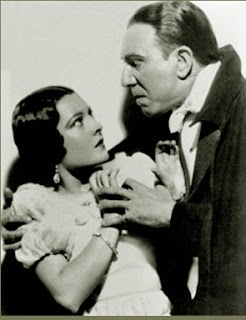
The 1931 Spanish-language version of "Dracula" was shot simulateously with the more famous Tod Browning version, using the same sets at Universal Studios but its actors and crew shot at night after production wrapped for the day on the other film.
Although treated as a secondary venture by Universal at the time, this film is actually superior to Browning's "Dracula" in many ways. Although it is about half an hour longer, the film seems to move faster due to superior story cohesion, better staging of many scenes, some of the best cinematography I've seen in any of the early talkies, and better acting on the part of many of the principles. For example, the famous scene where Van Helsing suprises Dracula with a mirror while the Count is visiting the Seward house is clearer and far more dramatic due to better placement of the camera and more efficient blocking of the scene in general; and the scene with the near-sexual assault that the Dracula-corrupted and suddenly very horny Eva (Mina renamed for the Spanish version, played with great effectiveness by Lupita Tovar) on Juan (the renamed Jonathan Harker, played by Barry Norton) is both far sexier and far scarier than the one featured in Browning's version.
Not everything here is better than in the Browning version, however. My favorite scene--where Dracula passes through a spiderweb without breaking it--is completely in this version, and the actor they have playing Dracula is more funny than scary or mysterious. Carlos Villar was apparently a big star in his day, but the reason for that is not evident in this film. He has one acting mode--over-acting--and he has two facial expressions, and they both look like he just smelled something that makes the stench from a baby's dirty diaper seem like a sweet-smelling rose. In fact, Villar's performance seems almost like he belongs in a spoof of "Dracula" instead of a serious movie, and he is so bad that if the Dracula character had gotten any more screen time, his presence would have destroyed the movie.
The Spanish-language "Dracula" is a film that anyone who loves the old Universal horror pictures should check out. While it suffers because of Carlos Villar's unintentionally comic performance, this is an excellent film, one deserving to be recognized and honored as a classic cinematic work.
Dracula's Daughter (1936)
Starring: Gloria Holden Otto Kruger, Edward Van Sloan, Marguerite Churchill, Irving Pichel, and Nan Grey
Director: Lambert Hillyer
Steve's Rating: Eight of Ten Stars
Dracula may be dead, but his vampire brides live on. While Van Helsing (Van Sloan) languishes in jail for murder, Countess Zaleska (Holden) steals Dracula's body from the police, blesses and cremates it in the hope that she will finally be free of her vampire curse. But, she finds she stll cannot resist the lure of human blood, so she seeks the help of a noted psychiatrist (Kruger) to assist her in finding a way to a peaceful life.
"Dracula's Daughter" is a far better movie than the film it is a sequel to. It has a coherent, engaging story (even if the ultimate climax has a of a rushed feel to it), its got an active and engaging hero (Dr. Garth, a psychiatrist who doesn't believe in vampires, even after one seeks his help), and a villain who wants desperately to be the story's protaganist, Countess Zaleska. What's more, the film has a steady tone and look to it--all classic Universal Horror--unlike :"Dracula", which vasilated between creepy, atmospheric scenes and boring, stale drawing-room scenes. (Of course, one can't be too hard on "Dracula", because it was treading new ground and was made on a sparse budget. By the time 1936 rolled around, and this film was released, not only was the horror genre well-established, but Universal was doing very, very well.)

Now, there are some plot holes that a swarm of bats could fly through if one considers it in the light of the original "Dracula"--like where are John Harker and Mina Seward, both of whom could help clear Van Helsing of the murder charge, just to mention the biggest one--and a couple of developments that feel just a little too convienient... but these are flaws that can be forgiven when one considers what a rare sequen this is. Not only is it better than its predecessor, but it has an identity all its own; it doesn't bring Dracula back so it can retreat the same basic plot all over again, but instead follows a new and unique path.
My favorite thing about the movie is the character of Countess Valeska. It's a character that oozes mystery from her first appearance through to the very end--she's the ultimate femme fatale in every way. She's also a character that, despite being a blood-drinking fiend, she's a character the audience gains sympathy for early on. Unlike the Dracula character, Valeska doesn't want to be evil, doesn't want to be a spreader of death and misery... she wants to live and let live. But, she can't shake the taint of Dracula, and she can't resist the call of vampirism. (It doesn't help any that she's got an evil bastard for a manservant, Sandor. One has to wonder how Valeska might have fared if she's just gone ahead and sucked him dry in celebration of Dracula's demise. Further, while the "recultant vampire" has been done over and over in movies and TV shows, Valeska, despite being the first, remains among the most enjoyable... because while she may lament her fate, she doesn't whine.
In fact, as I'm thinking about it, Countess Valeska is probably one of the best-presented, tragically romantic vampires in any movie I've seen, tying Jack Palance's portrayal in the 1973 Dan Curtis-directed "Dracula" adaptation starring Jack Palance. In both films, the audience can't help but root for the "bad guy" and can't help but feel sorry when their inevitable demise comes about.
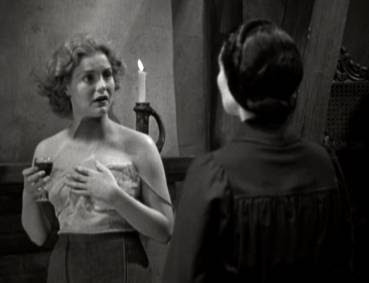
One thing that I've often seen made reference to in reviews of "Dracula's Daughter" is lesbianism. I've seen it commented upon as "subtext" and I've seen it stated that it's there, blatant and wide-open. And I simply don't see it; it looks like it's a case of critics reading too much into the film as it unfolds. The scene they tend to point to is the one involving Valeska and a young woman Sandor picks up for her. Maybe I'm just too innocent (or my mind just isn't deep enough in the gutter), but I see nothing sexual about that scene... or any other scene in this film for that matter.
"Dracula's Daughter" is a film that, like "Dracula" is a landmark of cinematic history. It may not be the most famous of films, but it can be found in the DNA of many vampire movies that have been made since. It's worth seeing by anyone who is a serious student of the development of the horror genre, as well as those out there who enjoys classic cinema.
Son of Dracula (1943)
Starring: Robert Paige, Frank Craven, Louise Allbritton, Lon Chaney, Jr., Evelyn Ankers, and J. Edward Bromberg
Director: Robert Siodmak
Steve's Rating: Seven of Ten Stars
Eccentric sothern belle Katherine Caldwell (Allbritton) apparently falls under the sway of a mysterious Transylvanian nobleman, Alucard (Chaney), while traveling in Europe. When he arrives in the United States, strange deaths start happening, and isolates himself and Katherine in her manorhouse on Darkwood Plantation. But after she is accidentially shot to death by her fiance (Paige), the true horror of what Katherine's plans start to emerge.
"Son of Dracula" is a surprisingly effective and mature horror film. I had very low hopes for it when Dracula shows up in Louisiana with the clever aka of "Alucard"--gosh, no one's going to figure that one out!
But fortunately, that's the one bit of childish idiocy in this exceptionally creepy movie.
From Dracula's takeover of Darkwood, to the first time we see Dracula emerge from his swampbound coffin, to Frank going insane from gunning down Katherine... and to the twists and turns the film takes as it moves through its second and third acts. (To reveal that Katherine dies at the hand of Frank is NOT a spoiler for this film. Her death is where the story starts to truly unfold.)
Every scene in this film drips with atmosphere. Despite dating from the mid-1940s where Universal horror films seemed to be targeted primarily at kids, this is a movie with a story that compares nicely to "The Mummy" and "Frankenstein". It may even be a little superior to those two, as far as the story goes, because it's got some twists that I guarentee you will not see coming.
The film is also blessed with a score that is surprisingly effective for a Universal horror picture--I tend to find them overblown for the most part, but here the music perfectly compliments what unfolds on the screen--and with a cast that is mostly superb in their roles.
I say mostly, because Lon Chaney Jr. is does not make a good Dracula at all. He comes across like a dockworker who's borrowed someone's tuxedo for the evening (or who maybe took it off the owner after beating him into unconsciousness). There simply is nothing menacing about Chaney's Dracula... he's brutish and, as the film builds to its climax, desperate, but never menacing or frightening. He is quite possibly the worst Dracula I've ever come across.
Aside from a weak "Dracula", everything else in this film is top-notch, resulting in a horror movie that's surprisingly effective and high quality when compared to the rest of Universal's horror output of the time. In fact, it's a movie that may even have been ahead of its time, as the pacing, style, and overall look of the film reminded me more of the British horror movies that would emerge from Hammer Films starting a little more than a decade after "Son of Dracula" was first released.
In fact, whether you prefer the Hammer Dracula films (as I do) or the Universal ones, this is a film that will appeal to you.
House of Dracula (aka "The Wolf Man's Cure")
Starring: Lon Chaney Jr., Onslow Stevens, John Carradine, Lionel Atwill, Martha O'Driscoll, Jane Adams, and Glenn Strange
Director: Erle C. Kenton
Rating: Six of Ten Stars
Unwilling, immortal werewolf Larry Talbot (Chaney) seeks out Dr. Edelman (Stevens), hoping the doctor's cutting edge therapies will cure his affliction. Unfortunately, the doctor's other patient, Count Dracula (Carradine), endangers this hope when he out of pure malice afflicts Edelman with a condition that causes him to become a violent madman at night. It is during one of these fits that Edelman revives Frankenstein's Monster (Strange), which has been dormant in his lab since it was recovered from mud-floes under Edelman's castle.
"House of Dracula" was the third sequel to "The Wolf Man" and "Dracula" and the fifth sequel to "Frankenstein"... and it was the next-to-last stop for all three of the characters as Universal's decade-and-half long horror ride came to an end. nearly the last stop for Universal's original monsters, and it is something of a high note when compared to other Universal horror films from around the same time, even the one to which this is a sequel, "House of Frankenstein" with Boris Karloff.
The script in "House of Dracula" is stronger and more coherent than "House of Frankenstein". The effort at maintaining continuity with other films featuring the character of the Wolf Man are in evidence here, and they are greatly appreciated by this continuity geek. Also, all the various monster characters each get their moment to shine--unlike in "House of Frankenstein" where Dracula was completely superflous to the storyline and whose presense was little more than a marquee-grabbing cameo.
In this film, Dracula is the well-spring of evil from which the plot flows. Although he supposedly comes to Dr. Edelman seeking release from vampirism and his eternal life, he is either too evil or too stupid to control his desires for Edelman's beautfiful nurse (O'Driscoll). He gets his just desserts, but not before he guarentees that every brave and goodhearted character in the film is set on a path of destruction.
The climactic scenes of this film, as the insane Dr. Edelman and Frankenstein's Monster go on homicidal rampages, feature some very, sudden, casual, and matter-of-fact brutality. (I can't go into details without spoiling the plot, but two main characters are dispatched with such swift and surprisingly brutal fashion that modern-day horror filmmakers should take a look at the final minutes of "House of Dracula" and attempt to learn some lessons from them.)
And then there's Larry Talbot. The role of the wolf man in this story is the meatiest since the character's debut in "The Wolf Man". Although he still doesn't get to have the stage to himself, and he is once again a secondary character--the main character of "House of Dracula" is the unfortunate Dr. Edelman--he has some great moments... like his suicide attempt and his discovery of the dormant Frankenstein's Monster.
Acting-wise, this is also one of the better than many other Universal horror films of the period. This is partly due to a superior script that features a story that actually flows with some degree of logic and where the actors have some fairly decent lines to deliever.
Lon Chaney Jr. does his usual excellent job as Larry Talbot, but Onslow also shines as a scientific genius who's a little less mad than the standard in a movie like this (well, at least until Dracula is done with him).

John Carradine performs decently, but I simply can't buy him as Dracula. Even in his younger years, he had the look of a burned-out, alcoholic bum, and the lighting and make-up in this feature strengthen that look as far as I'm concerned. While miscast, he does a decent job.
Lionel Atwill is also on hand for another fine supporting role. The part is similar to the one he played in "Son of Frankenstein", but the role is even more interesting, as he's the voice of reason in a town that is otherwise inhabited by villagers whose favorite pastime seems to be grabbing torches and storming the castle.
When all things are taken into account, this is the best "serious" Universal "Monster Mash" movies. It's second only in quality to "Abbott and Costello Meet Frankenstein" and I think it's a film that is worth seeing by modern horror fans... particularly if they also have aspirations of being filmmakers.
Abbott and Costello Meet Frankenstein (1948)
Starring: Bud Abbott, Lou Costello, Lon Chaney Jr., Lenore Aubert, and Bela Lugosi
Director: Charles Barton
Rating: Eight of Ten Stars
The reluctant Wolfman, Larry Talbot (Chaney) learns that Dracula (Lugosi) intends to revive Frankenstein's Monster and use it as his personal super-soldier. He pursues the evil vampire lord to the United States where he finds his only allies to be Wilbur and Chick (Costello and Abbott), a couple of less-than-bright shipping clerks. Unfortunately, Dracula as an ally of his own--mad scientist femme fatale Dr. Sandra Mornay (Aubert), and she has Wilbur wrapped around her little finger. Little does Wilbur know that his girlfriend doesn't love him for his mind but rather his brain... she intends to do Dracula's bidding and transplant into the rejuvenated monster!

"Abott and Costello Meet Frankenstein" is a wild screwball comedy with the two master comedians doing their usual routines within the framework of a solid script and a story that's actually pretty logical in its own crazy way. I think it's the first fusion of comedy and monsters, and one reason it works so well is that the monsters are played straight. Even when they are involved in funny schtick (Dracula and the Wolf Man are both part of several routines), they remain as they were featured in the serious monster movies they were in.
Too often, I hear this film written off as Universal's last and crassest attempt to wring some dollars out of their tired monster franchise. While that may be all the studio bosses had in mind, the creators involved with "Abbott and Costello Meet Frankenstein" managed to make a great movie that is still worth watching today. It's even superior to many of Universal's "straight" movies with Dracula, Frankenstein's Monster, and the Wolf Man (or, for that matter, countless recent so-called horror films). Much of its strength grows from the fact that has a plot that with some tweaking could be a straight horror movie.
I recommend this underappreciated film to any lover of the classic monster films, as well as lovers of slapstick comedy.






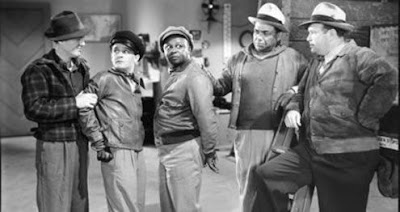












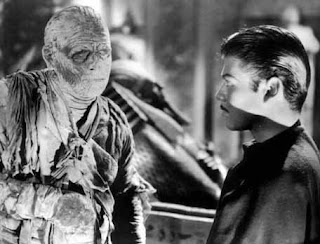







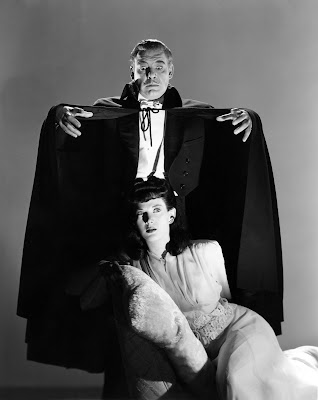





















.jpg)
